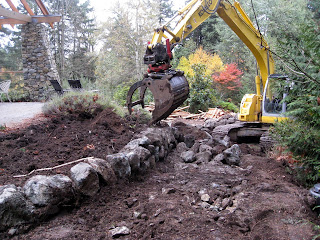Pattern Language # 106 Positive Outdoor Space
Problem - Outdoor spaces which are merely "left over" between buildings will, in general, not be used.
Apart from not having any other buildings on the property, there was a problem with there not being any desirable places to walk to or to spend some time in. With the house just sitting on a high spot on the lot the outdoors was all negative space - "the residue left behind when buildings - which are generally viewed as positive - are placed on the land," p.518 Pattern Language.
Tom is clearing the area behind the garage where a much-needed tool shed/potting area will be built. This building will help define the shape of the outdoor space down the side of the house and partly enclose it, turning it into an appealing positive space.
Tom hit bedrock while leveling the ground. He was able to break up some of the more weathered granite with the excavator bucket but the rest will have to be broken up using another method.
Tom said it is a quite rare 'salt and pepper' granite. I took a piece to my studio.
Looking north to the levelled site of the tool/potting shed with a track on the left and a garden bed on the right, both between the house and the forest and needing to be made into a positive outdoor space.
Tom worked backwards down the track as he constructed a rock wall to contain and define the garden bed running parallel to the west side of the house.
Solution to #106 Positive Outdoor Space
"Make all outdoor spaces which surround and lie between your buildings positive. Give each one some degree of enclosure: surround each space with wings of buildings, trees, hedges, fences, arcades and trellised walks, until it becomes an entity with a positive quality and does not spill out indefinitely around the corners." p. 522 Pattern Language.
At this stage, with just the earthworks and some structures in place, it is hard to see these outdoor spaces as positive design elements. I will come back to this pattern as work progresses and the space evolves.
Pathways are a very important element in outdoor spaces. They can help define a room or move people through a space. A pathway's course can cause you to pause or linger or encourage you to move towards a goal or focal point. Pathways link rooms, connect spaces, shift us through hierarchies of space, and influence our sensation of time.
Both Ron and I were excited by a pathway Tom built. We asked for steps to link the upper and lower levels but I had no idea Tom could make such a beautiful pathway.
Here is Tom standing on the partly constructed rising pathway while Ron stands at the top of it.
Just by the careful selection and placement of rocks with a flat plane, Tom was able to construct a most elegant stairway one can walk up and down with a natural gait.
When I saw it I realised it was a key element in the Backyard Project's design.
In my mind, I can see it all planted and its looks so inviting.







No comments:
Post a Comment